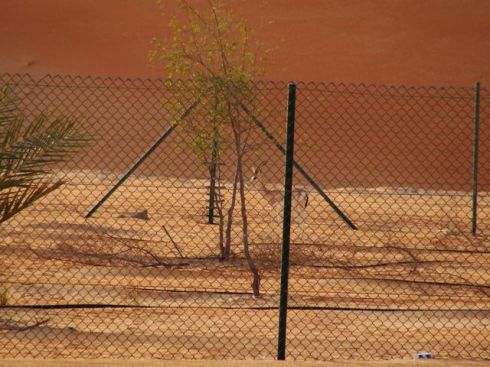The Arabian Oryx, called maha locally, is a truly beautiful and amazing animal. It, along with a certain type of desert lynx and the Arabian leopard here in Oman, is the focus of some fairly robust conservation efforts for which applause and attention should be given. Maha is also a favorite first name for girls in Oman, and one can see the reason why, given the animal’s combination of lithe body and toughness.
Maha are a type of gazelle, but with an exceptional ability. Like a camel, they can go days (and some say even a lifetime) without drinking water. This is an adaptation specifically designed to help it survive against predators. If chased by, say, an Arabian leopard, it heads out into the vastnesses of the Neged, or the Rub al-Khali, leading its stalker so deep into the wastes that the other animal has no choice but to turn back or die of dehydration. They are fast little creatures with curving horns and are even rumored to have been the source of the myth of the unicorn, for — when turned in profile — the two horns exactly mirror eachother in shape, giving the impression of but a single central horn.
Our one encounter with maha here in the Middle East occured in the UAE, rather than Oman (although Oman has set aside a huge tract in its Wahiba Sands area of the Rub al-Khali for Oryx conservation). There, in the UAE, Sheikh Zayed al-Awal had a fascination for greening the desert. All the way from the Oman border to Abu Dhabi and to Dubai, and then from Abu Dhabi all the way south to Mizaira’a and the other isolated villages of the Liwa Oasis, the edges of the freeway are ‘forested’ with date palm and scrubby thorn bushes, miles and miles of plastic pipe in the ground providing drips of desalinated water daily to each plant. Some of these forested areas are fenced. We wondered why. Watching, as we passed, we eventually discovered the reason: they’re used as a conservatory for the Oryx, with groups of 5 or 10 of the little creatures lounging in the shade. At first, driving past them, I thought I was seeing goats or dogs. Then I realized what they were and, though they usually scampered away when we tried to photograph them, we did snap this one fine photo, fence and all.
A creature like the maha seems wronged when shown with a fence around it. But, its really us, our human incursions into the desert, and our hunting of it to near-extinction, that have perpetrated the true wrong. We are what makes it necessary to institute a Not Quite Right like these fenced-in conservatories.


